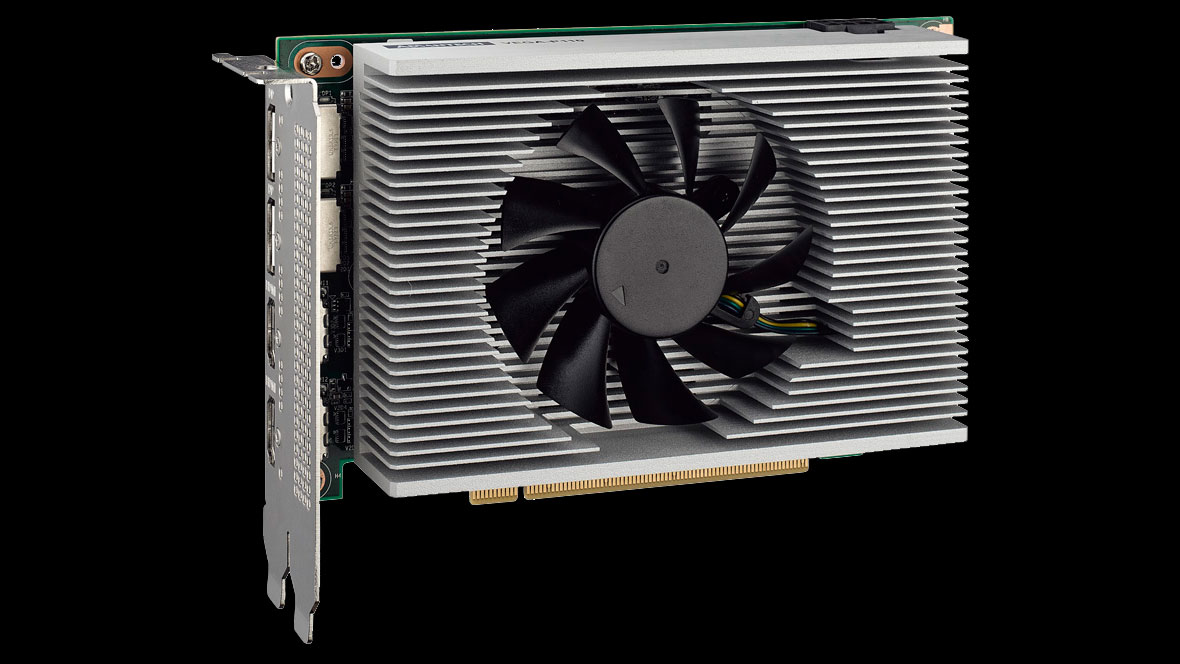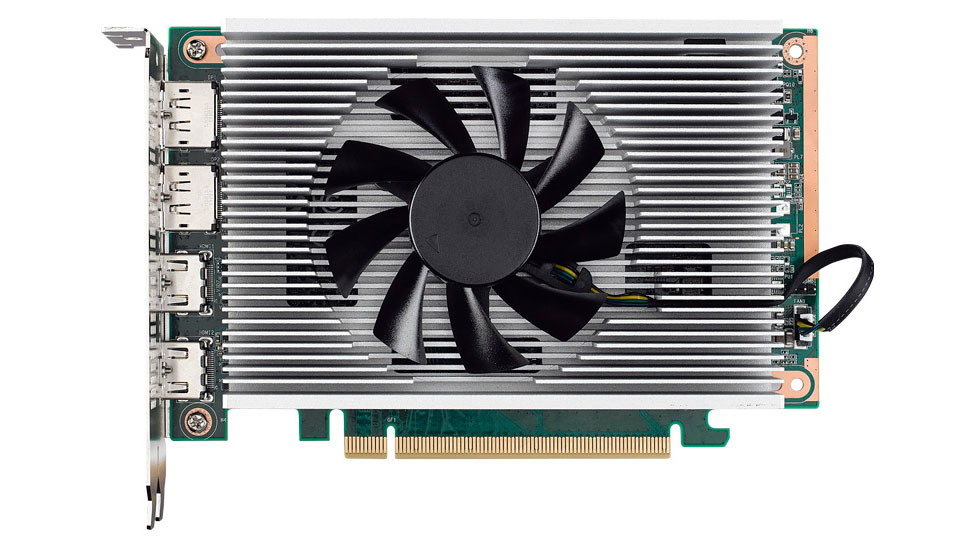Intel Arc A370M mobile GPU transformed into desktop card with the help of a heatsink and tiny cooling fan

Advantech has released the EAI-3100, converting Intel's Arc A370M mobile graphics card into one for the desktop. Although the EAI-3100 can't hang with the best graphics cards, the Arc-powered graphics card represents another option for gamers on a very tight budget. X (formerly Twitter) user momomo_us pointed it out first.
The EAI-3100 has a dual-slot design that measures just 6.61 inches (168 mm) long. It should fit into any half-decent PC case, both old and new. It has an aluminum heatsink that's as big as the whole PCB and depends on a small fan for active cooling. It's the cooling setup you'd find on an entry-level desktop graphics card.
Like the Arc A370M, the EAI-3100 sticks to a PCIe 4.0 x8 interface. Advantech didn't make any changes to the specifications. Given the more robust cooling solution, it's perplexing why Advantech doesn't offer a slight factory overclock on the graphics card. As a result, the EAI-3100 continues to operate with a 1,550 MHz graphics clock, capable of delivering up to 4.198 TFLOPS of FP32 performance.
While the Arc A370M has a TGP (total graphics power) ranging from 35W to 50W, the EAI-3100 has a maximum power consumption of 60W. A single PCIe x16 expansion slot, which delivers up to 75W, can provide enough power for the EAI-3100. So it is sort of mind-boggling that the manufacturer is implementing an 8-pin PCIe power connector on the EAI-3100. Perhaps Advantech wanted to leave consumers some headroom for overclocking, but even an 8-pin PCIe power connector is a bit much for an Arc A370M.


The EAI-3100 has two DisplayPort 1.4a outputs and two HDMI 2.0b ports. The configuration enables you to use up to four displays simultaneously. You can enjoy resolutions up to 7680x4320 at 60 Hz with DisplayPort 1.4a or 4096x2160 at 60 Hz with HDMI 2.0b.
The Arc A370M is a decent graphics card for gaming at 1920x1080 if you keep the image fidelity at reasonable settings. The graphics card delivers a gaming performance that surpasses the mobile Nvidia GeForce RTX 3050. Intel continuously improves the Arc driver, sometimes up to triple-digit enhancements, so the Arc A370M's performance should progress with time.
However, there are other uses for Intel's Arc Alchemist products, such as video encoding and AI workloads. The Arc A370M offers AV1 and VP9 hardware accelerated video coding and a ticket into Intel's OpenVINO world for AI. And if you own an Intel chip, you can leverage Intel Deep Link technology to impress performance.
Get Tom's Hardware's best news and in-depth reviews, straight to your inbox.
The EAI-3100 isn't available at your typical computer hardware retailers. Pricing hasn't been announced, but you can get a quote directly from Advantech.

Zhiye Liu is a news editor, memory reviewer, and SSD tester at Tom’s Hardware. Although he loves everything that’s hardware, he has a soft spot for CPUs, GPUs, and RAM.
-
Notton I hope it's dirt cheap, because it's neither a single slot, or low profile for a <75W card.Reply
Looking at the numbers, the A310LP is faster, but maybe if the A370M is unbound it can do better?
For comparison, RX 6400 has around 1.8 times the performance.
IDK, maybe if it's cheap enough, it might be a good AV1 encoding card. -
jlake3 The reason they didn't offer a factory overclock is probably because they're marketing it for embedded systems and guarantee 5-year longevity. Casino/arcade graphics, medical imaging, and detecting manufacturing defects via computer vision are the highlights of their marketing reel. Gonna be competing with the AMD E-series and the Matrox D-Series or Luma line in those applications.Reply
Knowing industrial parts, I'd guess that the validation and enhanced support actually makes it more expensive than a standard A380, and thus a terrible option for "gamers on a very tight budget". -
HideOut Reply
Its on a PCIe card, its not embeded. Embeded is soldiered to the MOBOjlake3 said:The reason they didn't offer a factory overclock is probably because they're marketing it for embedded systems and guarantee 5-year longevity. Casino/arcade graphics, medical imaging, and detecting manufacturing defects via computer vision are the highlights of their marketing reel. Gonna be competing with the AMD E-series and the Matrox D-Series or Luma line in those applications.
Knowing industrial parts, I'd guess that the validation and enhanced support actually makes it more expensive than a standard A380, and thus a terrible option for "gamers on a very tight budget". -
jlake3 Reply
A single board system is typically what is thought of, but definitionally an "embedded system" is a single-purpose system that's a part of a larger device/machine. Soldering to the motherboard is not a requirement. If you're using these in an industrial inspection machine, a terminal that controls one specific medical device, or in an arcade cabinet that only runs one game, that's considered embedded computing. https://en.wikipedia.org/wiki/Embedded_systemHideOut said:Its on a PCIe card, its not embeded. Embeded is soldiered to the MOBO -
hennes Reply
Why only max 4 displays? With 2 display ports I expected (2x4) per display port, plus bot HDMI bringing it to a total of 10.Admin said:Advantech has launched the EAI-3100, essentially a desktop version of Intel's Arc A370M mobile graphics card.
Intel Arc A370 mobile GPU transformed into desktop card with the help of a heatsink and tiny cooling fan : Read more
Usual caveeats apply. E.g MST suported, and 1080 TV resolution. Wich is not a bad resulution for walls of displays, though I will take 4K anytime for productivity. -
artk2219 Reply
You're not wrong in terms of embedded components, but embedded systems are different, those are systems that are embedded in place, so they don't move. Slot machines, ATM's, PC's that power menu displays at restaurants or ticket listings all over the place, would be considered embedded systems. Those could be systems where all the components are also embedded, or they could be desktops with discrete components. Either way, those components typically have been designed to have long boring service lives and require minimal maintenance.HideOut said:Its on a PCIe card, its not embeded. Embeded is soldiered to the MOBO